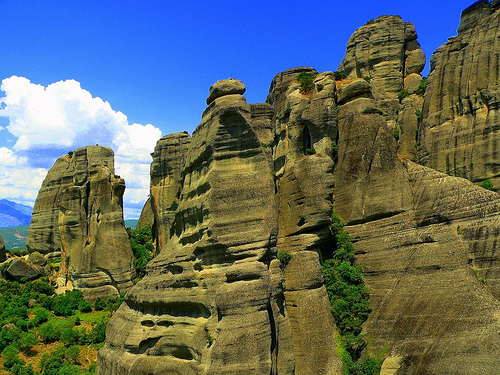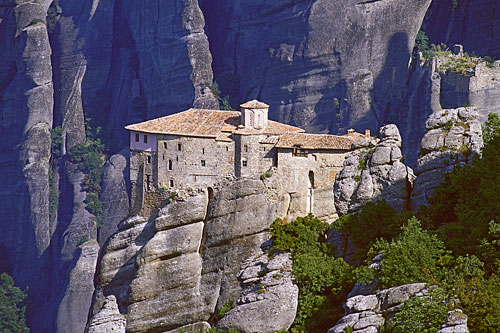Studies suggest that the pinnacles were formed about 60 million
years ago during the Tertiary Period.Weathering and earthquakes
then shaped them into their present shape. Beside the Pindos
Mountains, at the western region of the Thessaly plain in the
middle of northern Greece, these sandstone rocks rise from the
ground. The rocks are composed of a mixture of sandstone and
conglomerate. They were formed about 60 million years ago. A series
of earth movements pushed the seabed upwards, creating a high
plateau and causing many fault lines to appear in the thick layer
of sandstone.


Continuous weathering by water, wind and extremes of temperature
turned them into huge rock pillars, marked by horizontal lines
which geologists maintain were made by the waters of a prehistoric
sea. Greek historian Herodotus wrote in the 5th century BC that
local people believed the plain of Thessaly had once been a sea. If
this was accurate, there was most probably an inundation at the end
of the last Ice Age, around 8000 BC. However, he failed to mention
the rocks of Metéora, and nor are they recorded in the writings of
other ancient Greek authors. This has led to the belief that the
pinnacles did not exist 2000 years ago; a theory dismissed by
modern geologists.


The cave of Theopetra is located at the foot of the cliffs.
Excavations and research and have discovered petrified diatoms,
which have contributed to understanding the Palaeo-climate and
climate changes. Radiocarbon data evidences human presence dating
back 50,000 years The cave is closed to the public.
But as amazing a marvel of nature as these giant rocks are the
buildings on the top of these are a marvel of man and seem just as
miraculous and make Meteora one of the most spectacular places to
visit in Greece.
The area of Meteora was originally settled by monks who lived in
caves within the rocks during the 11th Century. But as the times
became more unsure during an age of Turkish occupation, brigandry
and lawlessness, they climbed higher and higher up the rock face
until they were living on the inaccessable peaks where they were
able to build by bringing material and people up with ladders and
baskets and build the first monasteries.


This was also how the monasteries were reached until the
nineteen twenties and now there are roads, pathways and steps to
the top. There are still examples of these baskets which are used
for bringing up provisions. But now you don't have to worry about
ropes breaking since the monasteries are all connected by a series
of pathworks that if you begin early enough you can see them all in
one day. They are also connected by roads so if you are coming by
car and don't have all day to wander around you can also get close
enough and then continue on foot.
Only six of the monasteries remain today. Of these six, five are
inhabited by men, one by women. Each monastery has fewer than 10
inhabitants. The monasteries are now tourist attractions.

Source wikipedia.org and greecetravel.com

To log this earthcache please answer by email to the following
questions:
a. What is the altitude at the Great Meteoron Monastery?
b. How many steps you have to climb to reach the Monastery of
Varlaám?
optional: Take a picture of you and the near one of the
Monasteries
You can start logging immediately. I will contact you in case of
any issues.


Free counters